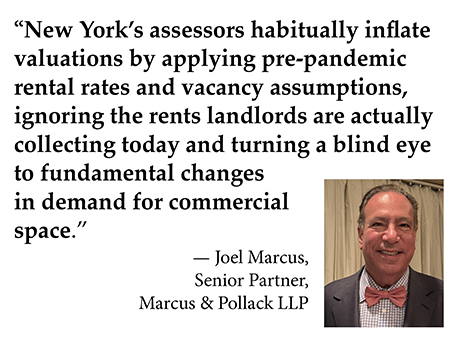By Joel Marcus, senior partner, Marcus & Pollack LLP
COVID-19 and the government-ordered shutdown had immediate negative consequences for all types of real estate, and New York City’s tax valuations took this into account. Damage from the pandemic still weighs down property values today, compounded by cultural shifts that sapped demand for commercial properties.
Fair market values have evolved to reflect pervasive vacancy, building obsolescence and the heightened cost of serving tenants that have abundant alternatives to choose from. At the same time, work-from-home practices reduce space requirements. Retailers, restaurants and hotels see half the foot traffic they once had from nearby office buildings, adding to ongoing pressure from e-commerce and other challenges to create excess vacancy, constrained rental streams and declining market values.
Valuation for property taxation has not evolved, however, judging by the revaluation tax assessments the city’s Department of Finance is issuing.
Revaluations ostensibly update taxable property values to current fair market value. Yet New York’s assessors habitually inflate valuations by applying pre-pandemic rental rates and vacancy assumptions, ignoring the rents landlords are actually collecting today and turning a blind eye to fundamental changes in demand for commercial space.
Old thinking persists among these assessors, and it haunts revaluation tax assessments.
No Going Back
The commercial real estate sector will never fully return to the way things were before COVID-19. Here is why:
Many shuttered service businesses and stores — dry cleaners, shoeshine stands, shoe stores, department stores — are unlikely to return because changing consumer preferences slashed demand for their services. Dressing up for work is history; offices are downsizing, and remote work is the new protocol.
Kastle Systems, which monitors office occupancy as people on site, shows average office attendance in New York City is a little more than 50 percent of the baseline occupancy level set before the pandemic. Foot traffic from office workers is half what it was six years ago, and ancillary businesses that thrived on that traffic have not returned.
Office, retail and hotel occupancy rates have recovered somewhat from record post-pandemic lows, but sustained vacancies, empty stores and retailer struggles persist. However, the Department of Finance is ignoring the limited extent of recovery. For example, assessors stubbornly value retail properties by ignoring vacancies and imputing market rents to stores that are still empty after three or four years.
To make matters worse, these market rent estimates rely on pre-pandemic rents, even though rents for many operators have plummeted. Properties that produced $350 per square foot are now asking $150 per square foot, and some stores rent below $100 per square foot. The assessor is clinging to the past, and valuations fail to reflect the reset in real market value.
Office Evolution
Office usage has declined with downsizing and remote working. Three onsite days a week is a common standard and has reduced many employers’ space requirements. Some companies with long-term leases sublet all or part of their spaces, while others cancelled expansion plans and reduced their footprints.
Subleases almost always involve discounted rent, so landlords competing with sublease offerings must reduce asking rent to compete for tenants. But the New York tax assessor gave no effect to these demonstrated reduced market rents.
Because the assessor continues to rely on the rates in master leases to capitalize income to market value, they prevent valuations from dropping to true market levels. A parallel problem occurs in retail, where sublease rates for major retailers are sometimes half or one-third of prime leasing.
Now that some major employers have mandated a full-week return to the office, another phenomenon is occurring. In the refurbished Class A environment, landlords provide tenants with gyms, play areas, lounges and even dedicated lunch and breakfast environments to help lure employees to the workplace.
Landlords often provide these amenities outside of tenants’ leased spaces, reducing the property’s rentable square footage. Where amenities are within the tenants’ leased footprints, the additional square footage translates into lower density or more square feet per employee for that occupier, and the landlord has much higher occupancy costs.
Taken as a whole, reconfigurations that dedicate a lot of space to amenities incur substantial costs to landlords without a significant increase in market rent to justify the expense. Moreover, owners of Class B buildings that were not upgraded are finding that their properties are outdated and obsolete. For example, the market rents achievable along Manhattan’s Third Avenue corridor are too low to justify the cost of conversion and tenant improvements.
Change for the Worse
The coup de grâce for property taxpayers is the difficult review and correction process they are required by law to follow to remedy assessment overvaluation and tax inequities.
During the pandemic, almost every city agency adopted a remote work schedule and most — notably the Tax Commission and Law Department — still maintain a work-from-home regimen. With city personnel in the office just three days each week, fewer people are examining assessment appeals, and the city is failing to grant review hearings to remediate those applications, as required by law.
In-person negotiation is long gone, and videoconferencing is the only option to review assessment appeals in New York City, making it nearly impossible to adequately review floor plans, photographs, spreadsheets and leases with city officials. Moreover, mandatory written submissions are replacing video hearings. Many city personnel have retired or vacated positions that remain unfilled, further straining the process.
Taxpayer teams must navigate this problematic post-pandemic framework, however, to contend with assessors who cling to historical market assumptions. By refusing to recognize reduced market rents and owners’ rising costs, assessors are keeping New York’s assessment values unrealistically high.
Joel Marcus is a senior partner at law firm Marcus & Pollack LLP, the New York City member of American Property Tax Counsel, the national affiliation of property tax attorneys. Contact him at jmarcus@marcuspollack.com.


